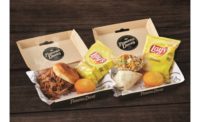Snack Food and Wholesale Bakery was recently able to speak with Greg Thorsgard, COO of Hazelnut Growers of Oregon, and Quality Control Manager Mark Clute, on getting SQF Certified, as well as challenges from the COVID-19 pandemic.
Liz Parker: How does a facility become SQF 3 certified?
Mark Clute: I'm the quality control manager, and I've been here since the very beginning of the plant. We decided early on that to be competitive in the marketplace, especially in the retail and the value-added products, so we needed to be a Global Food Safety Initiative or GFSI compliance, or certified, operation. So we chose SQF, which is Safe Quality Foods, and that basically is a set of standards that is outlined by the Global Food Safety Initiative, that deals with all aspects of the business regarding food safety, and then they have a bolt-on standard which is the quality standards.
So we decided to go for all of that, which would give us SQF Level 3. Only about 12 percent of the companies that go for SQF or RSQF certified are Level 3. It's quite an undertaking, which involves designing about 80 different programs for the plant including a formal plan. Training materials, pest control, allergen control, food fraud, food defense, basic food safety program, Good Manufacturing Program, and just a whole bunch of other programs—product development programs and a documentation program.
[Basically, everything that] has to do with the facility and the processes and how we control that. Within SQF, there's about 180 sections or points that you got to comply with. So we spent nine months between the time I came on board and the time of our first audit. The way SQF works is that they ask you initially to do a desk audit, where they will come in and they will look at all your programs and documents and they will review that. Then, you have 45 days to take their suggestions and bring them up to where they would feel they are compliant, and then they will send another auditor out and then they audit your facility and those original documents again.
Then they will determine whether you are Level 2 or what level you are at. We chose not to do that—because of my background, we decided to go ahead and just go directly to the audit. So we created all the systems and we did all the internal work ourselves. Then the auditor came out and we achieved SQF Level 3 the first year.
It's quite an undertaking, and I don't think anybody could do it in nine months. I didn't think at the time that we could do it, but we have a great team and [they’re] very committed to building a quality-conscious, food-safe program and products. It really paid off, and it is a very in-depth program.
Greg Thorsgard: I came on [to the team] about a month before that first audit and I have been in food manufacturing for 30 years. When Mark told me that we were getting an SQL audit, I said, so will it be first stage? And they said—oh no, we're going for level 3—and I actually laughed because I thought they were joking with me.
I have never experienced anybody doing it in less than three to five years. So it was pretty monumental to come right out of the gate and achieve that. I have never heard of anybody doing it before.
Liz Parker: What makes this year the largest hazelnuts harvest? I.e., what steps were taken to get there?
GT: So the harvest is really just a byproduct of the plannings that have been going on for the last seven years. There's been an increase in farmers putting in more orchards, and also migrating to the new varietals that are Eastern Filbert Blight-resistant. Those have started generating in the last two years and I would say every year the acre count has gone up, with hazelnuts being planted here in Oregon, until just recently, it started to level off. I think it's just a byproduct of interest and the demand for high-quality nuts coming out of Oregon.
Liz Parker: What setbacks has HGO dealt with in regards to the pandemic and government-mandated shutdowns?
MC: The largest setbacks are the fact that we had to implement new processes and programs. That included the six-foot distancing, and extra sanitation, and wearing of masks, and that impacted our operation. If we had to have six-foot distancing that meant we couldn't have people or staff come in all at the same time, because they would be all in the locker room or in the wash plant or wash station at the same time. We had to separate people in the facility proper. So we had to make sure that their work stations were separate, and in the places where we couldn't get a six-foot proper distance, we had to implement face mask rules, splatter shield rules, and other precautionary methods to keep people safe.
We also had to do a huge amount of extra sanitation. We hired an extra person to do [this]—extra wiping of the doors, extra wiping of the tables and the seats and the lunchroom, and all the contact surfaces that we don't think twice about. Another thing we did is we had to implement a temperature control program, where we hired a Coronavirus safety officer.
Everybody who comes into the facility has to be temperature-checked. Okay, they get their temperature checked to make sure that they comply with the standard before they can go into the facility proper, and then the safety officer walks around the facility and makes sure that everybody is always wearing their masks and making sure that their face shields are down and they’re distancing correctly.
So there are lot of additional costs that the company is being burdened with because of COVID-19, and the governmental mandates that are being placed upon us. It’s quite in depth, but we've been very fortunate, unlike a lot of the companies where they had shutdowns. We’re very careful to make sure we don't, because if we're in the harvest and we've had a shutdown, that could be a very serious problem.
GT: I agree with everything that Mark has just said. Our efficiency has gone down and our cost to produce has gone up, and I can't imagine any food manufacturing plant that hasn't been affected negatively by that. Unfortunately, that drives all the way through the supply chain. Nobody is talking about it, but food prices [will be have to driven up] for manufacturing to stay viable.
LP: Any predictions for hazelnuts in 2021?
GT: We are looking at almost a duplication of this year’s crop. We believe in 2021. We are fairly good at predicting the macro size of the crop from year to year, because hazelnut trees are altered in bearing—one year they bear a heavier crop, and then they recover. The second year they still have a crop, but not as heavy. So we kind of have an idea based on the number of acres, and the current crop yields what we should be getting next year, and it should be very similar to what we have this year. This is a record year and we expect to basically repeat it in 2021.
MC: We expect it to only go up from here. The farmers are still planting. They're slowing down a little bit on their planting, but if our model comes to fruition the way we believe it [will], then more farmers will plant more hazelnuts, because the quality of our hazelnuts from a worldwide review is better than what they can get anywhere else. So, customers will be coming to us to buy products.






